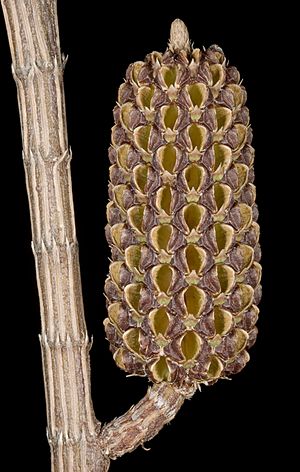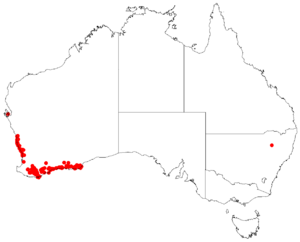Dune sheoak facts for kids
Quick facts for kids Dune sheoak |
|
|---|---|
 |
|
| Scientific classification | |
| Genus: |
Allocasuarina
|
| Species: |
lehmanniana
|
 |
|
| Occurrence data from AVH | |
The Dune Sheoak (Allocasuarina lehmanniana) is a special type of shrub found only in Western Australia. It's often called "dune sheoak" because it grows a lot along the coast, especially in sandy areas. This plant is part of the Casuarinaceae family.
Contents
What Does It Look Like?
The Dune Sheoak grows as an upright shrub and can reach a height of about three to five metres (10–16 ft). This is like a small tree!
Instead of wide leaves, it has long, thin green branches. These are sometimes called "needles," but their proper name is cladodes. These cladodes are made of many small parts, like tiny segments. The plant's true leaves are very tiny teeth that wrap around each joint on the cladodes.
Flowers and Cones
Most Dune Sheoak plants have either male or female flowers. However, some special plants can have both!
- Male flowers: These grow as small brown spikes at the very end of the branches.
- Female flowers: These are tiny and grow on their own short branches.
After the female flowers are pollinated, they develop into egg-shaped cones. These cones are about 1½ to 3 centimetres (0.6–1.2 in) across.
Where Does It Grow?
The Dune Sheoak is found only in Western Australia. It grows widely along the coast. You can find it from the Murchison River in the north, all the way south to Israelite Bay.
Its Discovery
The Dune Sheoak was first collected by a person named Johann Priess in 1840. Collecting plants helps scientists study and understand them better. The plant's specific name, lehmanniana, was given to honor another important botanist named Johann Lehmann.
Different Types
There are two main types, or subspecies, of Dune Sheoak:
- Allocasuarina lehmanniana subsp. ecarinata
- Allocasuarina lehmanniana subsp. lehmanniana

